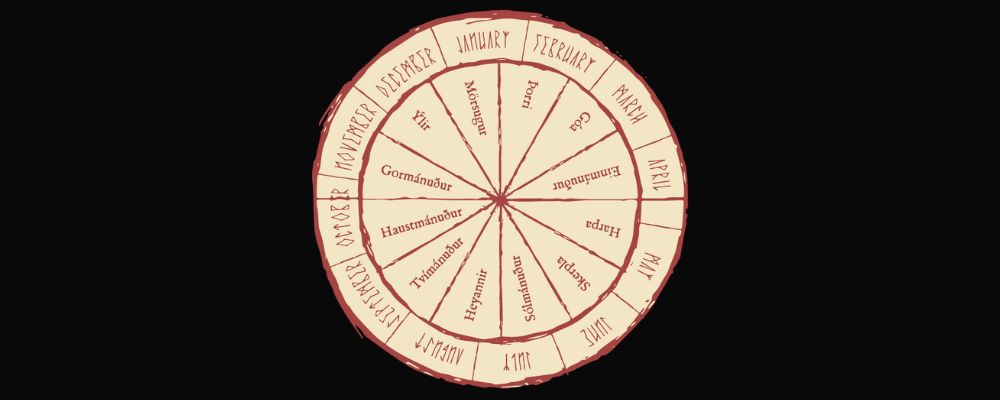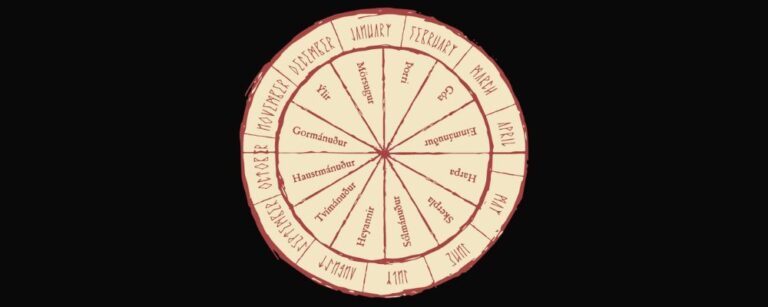One of the things that we get asked about most is Norse holidays. Which ones did the Vikings celebrate, how did the Vikings mark them, and how do they relate to the important holidays that we celebrate today?
With those questions in mind, let’s take a look at the Norse calendar and how it frames the year. Let’s also look at the major festivals that were celebrated by the Vikings, and the festivals that are important in modern Heathenry.

Norse Calendar
The Norse calendar is a lunisolar calendar, which means that it uses both lunar and solar movements to mark time.
The movement of the earth around the sun is used to count the year itself. The year is also broken into two halves: Nattleysi, or “nightless days” which is of course Summer, and Skammdegi, “short days” so Winter.
The Vikings did not have a specific numbering system for the years themselves but rather marked years in relation to one another. For example, an event may have happened ten years after the death of Ragnar Lothbrok or two years after an important battle. The Vikings started to use the Christian system for counting years from the 12th century.
Ages were counted in how many winters an individual has seen. This may suggest that the Viking year officially started in April, at the start of the summer half of the year.
Months were marked by the cycles of the moon, with 12 lunar months each lasting 30 days. The Viking months began mid-month compared to today’s calendar, and were roughly the following:
· Harpa – April to May – First month of the year marking the start of summer and probably named for a forgotten goddess.
· Skerpla – May to June – The name of the month seems to refer to vigor and abundance. It may also have been called Eggtid, which means “egg time”.
· Solmanudur – June to July – The name means “sun month” and marks the beginning of summer in earnest. Additional days of the year were added in the transition between this month and the next.
· Heyannir – July to August – The name of the month means “hay season”.
· Tvimanudur – August to September – The name of the month probably refers to the fact that it is the second last month of the summer season.
· Haustmanudur – September to October – The last month of the summer.
· Gormanudur – October to November – The first month of winter, the name means slaughter month and probably indicates that this was the time of year when animals were slaughtered ahead of winter.
· Ylir – November to December – Named for the important Viking festival of Yule of Jol, which arrives in the following month.
· Morsugur – December to January – The name of the month means “fat sucking month” and probably refers to the large amounts of stored fat in the Viking diet at this time. It was also called Jolmanudur, which means “month of Yule”.
· Thorri – January to February – The month is named for Thorri, a god of frost (not to be confused with Thor).
· Goa – February to March – The goddess Goa is also a deity associated with winter and therefore gives her name to this month.
· Einmanudur – March to April – The name literally means lone month, which may be because it is the last month of the year or the loneliest month at the end of a long winter.

The use of 30-day months meant that the months and the years quickly fell out of sync, so every few years extra days were added in Summer, called Sumarauki, which brought the year back into sync. This alignment of the months meant that each month always started on the same day of the week. For example, the start of Summer in April always fell on a Thursday.
The Viking has weeks, which also comprised seven days.
· Sunnudagr – Sunday, the name means “sun day”.
· Manadagr – Monday, the name means “moon day”.
· Tysdagr – Tuesday, named for the god Tyr, a god of war and justice.
· Odinsdagr – Wednesday, Odin’s day, named for the most important Norse god.
· Thorsdagr – Thursday, Thor’s day, named for the protector of Asgard and Midgard.
· Frjadagr – Friday, the name may refer to the goddess Freyja or Frigg. The two goddesses may have been one and the same in early Norse times.
· Laugardagr – Saturday, but literally “bath day”. The Vikings were known for their hygienic practice of bathing once a week.
We know what the Norse calendar looked like thanks to the survival of scores of Norse calendars from Iceland, Norway, and Sweden dating from the 13th to the 18th centuries.
The oldest surviving Norse calendar is from Nyköping in Sweden and was engraved into a staff. Unfortunately, the original has since been lost, and only a copy for the summer half of the year was made. Another important calendar is Worm’s Runic Calendar, which dates to 17th century Norway.
However, because these calendars date from the Christian period, although they use the old Norse months, the festivals marked on the calendars are Christian.

Viking Festivals
The most important dates in the Viking calendar were linked with the solstices and equinoxes. This makes sense since these celestial events would have been highly noticeable, especially at more northerly latitudes.
These events can also be linked to the changing of the seasons, which would have largely dictated life in the Old Norse world as this told the Vikings when to plant, when to harvest, when to hibernate, and when to set sail.
The major festivals, called blots, in the Viking calendar also aligned with these important celestial events. We do not have a complete calendar of all the dates that were marked, but we have an idea about some of them thanks to references in the surviving histories and sagas.
Sigrblot – Mid April
Sigrblot was marked on the first day of Harpa in April and marked the start of summer and probably the start of the Norse calendar year. The sources suggest that offerings were made to Freyja at this time of year. She was associated with fertility, and therefore the world coming back into bloom after winter.
Alfarblot – Late October.
Alfarblot was marked at the end of October, which marked the start of Winter, and is often associated with Halloween and the old Celtic holiday of Samhain. It was considered a time of year to honor the ancestors (the dead), and it was a dangerous time of year when the veil between the worlds was thin and supernatural entities had greater power. Rather than being a large public festival, it was a private festival celebrated in the home.
Read our full blog post of Alfarblot here.
Jol/Yule – Late December
The Vikings celebrated Yule during the second half of December when the days were at their shortest and coldest. It was considered a dangerous time of year when the god Odin was abroad with the Wild Hunt. Anyone caught alone out of doors was at risk. Sacrifices were made to various gods, including Odin, Thor, and Freyr, probably to ensure survival during these last difficult months before the coming of spring. Many Viking Yule traditions have been adapted into modern Christmas traditions.
Read our full blog post of Yule here.
While there certainly would have been other important festivals celebrated throughout the year, and we know that the Vikings would take almost any excuse to gather, we can’t say much about the other festivals based on the surviving sources.

Heathen Festivals
If you look at the Heathen calendar, you will see a lot more dates marked. But it is important to remember that Heathenry is a form of modern paganism, and the Heathen calendar of festivals was only really developed in the 1970s. It draws on Norse tradition, but also other Pagan and Wiccan traditions.
The calendar of annual festivals used by most followers of Asatru in Scandinavia today is listed below.
· Julblot – Late December/Winter Solstice – linked with Odin and Freyr.
· Disablot – February – linked with the Disir, which are nature spirits, usually female.
· Varblot – March/Spring Equinox – linked with the Vanir gods, especially Freyr and Freyja, and the light elves.
· Majblot – Late April/Early May – fertility festival linked with Freyr, Thor, Sif, and Jord.
· Midsommarblot – Late June/Summer Solstice – another fertility festival linked with the Vanir gods.
· Sensommarblot – Early August – fertility festival linked with Thor and Sif.
· Hotsblot – Late September/Autumn Equinox – linked with Frigg, Freyr, Ullr, and Skadi.
· Alvablot – Late October/Early November – a celebration of the ancestors.

Modern Viking Calendar
In our opinion, for modern Vikings, it is not particularly important to celebrate specific festivals on specific dates. What does matter is connecting with the natural rhythm of the year. The Vikings recognized that they were part of nature rather than separate from it, and they aligned their lifestyle with nature. Marking the changing of the seasons and important celestial events reflects and honors that.
Viking festivals often seem to have honored multiple gods, with sacrifices to gods such as Odin, Thor, Freyr, and Freyja made together. They also blurred the lines between gods, dead ancestors, elves, and nature spirits. They were often honored together and clear distinctions between the different groups did not seem to be particularly important.
Individuals, households, and communities honored the gods in their own ways.
The perfect accessory for any Viking festival is a Thor’s Hammer pendant. The Vikings wore Mjolnir pendants as symbols of protection and allegiance to the old gods. Check out the Mjolnir pendants available in the VKNG store.


Get Your FREE e-Book
Norse Gods, Monsters & Myths







